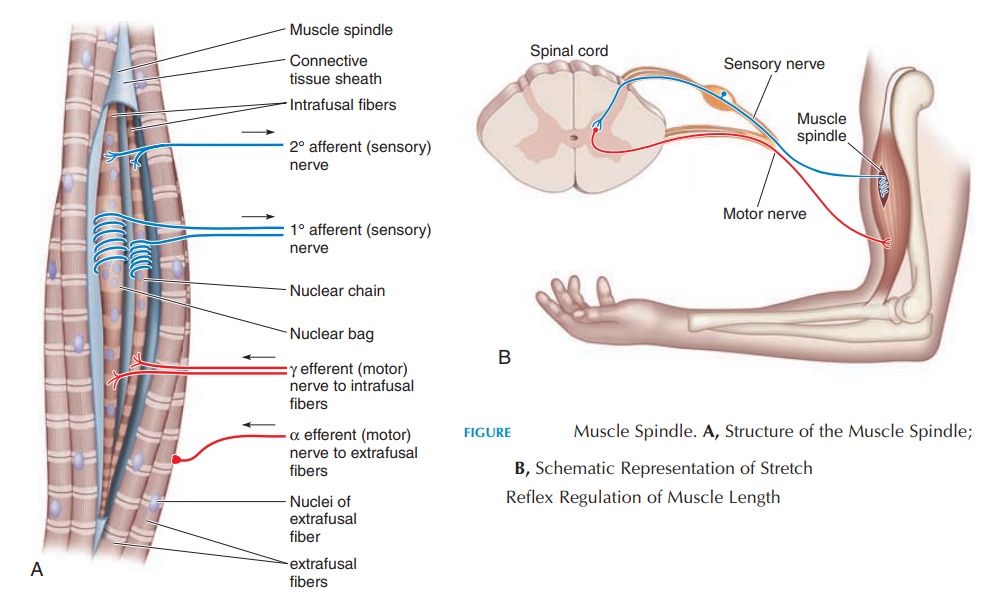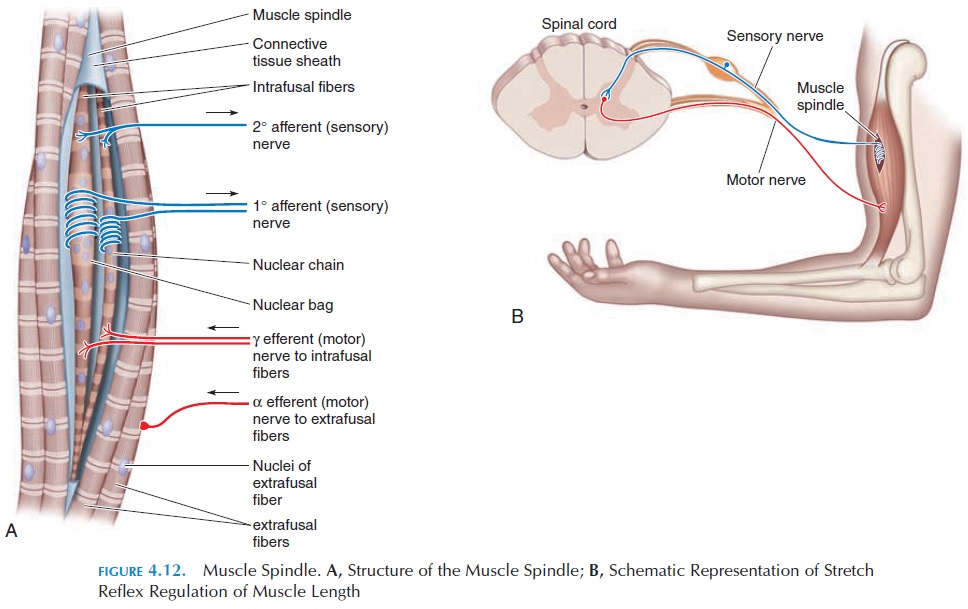Chapter: The Massage Connection ANATOMY AND PHYSIOLOGY : Muscular System
Muscle Spindles

MUSCLE SPINDLES
Muscle tone is maintained by stimulation of special-ized tissue (muscle spindles) scattered within the muscle. Muscle spindles are modified muscle fibers: 3–10 fibers that are surrounded by a capsule, giving it a spindle shape (see Figure 4.12). The ends of the muscle spindle capsule are attached to endomysium and perimysium. The muscle spindles are located parallel to other muscle fibers, and their length is al-tered as the whole muscle stretches or contracts. On average, the length of the muscle spindle varies be-tween 2–4 mm (0.08–0.16 in). The number of muscle spindles in each muscle is variable. Muscles of the arms and legs have the highest number, with the muscles of the hand and foot having an abundance.

The specialized muscle fibers in the muscle spindle are known as intrafusal fibers. The actin and myosin in the intrafusal fibers are concentrated to-ward the ends of the capsule. The intrafusal fibers have their own sensory and motor nerve supply. The gamma motor neurons supply these fibers in com-parison with the other regular muscle fibers (extra-fusal fibers) that are supplied by alpha motor neu-rons. Because the cell bodies of both motor neurontypes lie in the central nervous system, the brain can control the contraction of intrafusal and extrafusal fibers. When the gamma motor neurons are stimu-lated, the proteins (actin and myosin) concentrated at the ends of the muscle spindle contract, stretching the middle of the muscle spindle.
In addition to the motor nerves, the center of the muscle spindle is surrounded by special sensory nerves that generate impulses every time the length of the muscle spindle is altered. The impulses are con-veyed to the cerebral cortex, providing feedback with regard to muscle position. Impulses are conveyed to the cerebellum as well. This helps the brain coordinate muscle contraction. The sensory nerves also synapse (communicate) with motor neu-rons that innervate the muscle in question. Thus, re-flexively (a reflex is an automatic, involuntary motor response to sensory stimulation), the muscle con-tracts when stretched to prevent overstretching the muscle. This reflex (stretch reflex) also helps alter the muscle tone according to changes in posture. Thus, the muscle spindlesfunction as stretch receptors that inform other neu-rons in the brain and spinal cord of muscle length and the rate at which the muscle is stretching.
Because muscle spindles have their own motor supply, the degree of stretch of the muscle spindle can be altered by gamma motor neuron. For example, if the gamma motor neurons are stimulated before the muscle is lengthened, the middle of the muscle spin-dle is stretched even before the muscle actually lengthens. This, in turn, stimulates the sensory neu-rons located at the center of the spindle. By altering the degree of shortening of the contractile ends of the muscle spindle, the sensitivity of the sensory part of the muscle spindle can be regulated. Note that the muscle spindle can be stretched by two mechanisms:
(1) by stretch of the whole muscle, and (2) by stimu-lation of the gamma motor neurons that produce con-traction of the ends of the muscle spindle.
The activity and sensitivity of muscle spindles can be altered by exercise training. Thus, training can produce an increase in the resting tone of exercised muscles.
Related Topics